SHS’s Cancer Research Experiment to Launch to the International Space Station
Stamford, CT – An experiment developed by Rithin Armstrong and Lizet Garcia as 12th grade students at Stamford High School is scheduled to launch to the International Space Station on Thursday, June 3 as part of Mission 14 to the ISS. The launch for this experiment was delayed due to a Covid-19 lockdown at NASA and SpaceX delays. The experiment will launch from the Kennedy Center at Cape Canaveral, Florida as part of the Apollo experiments payload on a SpaceX CRS-22 rocket.
Rithin Armstrong is currently a Dean’s List student in the Honors Program at UCONN Storrs. Lizet Garcia is a freshman at the University of Richmond in Virginia. Both students recently returned to Stamford High School to prepare the experiment with virtual guidance from research scientist Maggie Ahearn of Nanoracks, NASA’s partner for payload preparation.
“We are so honored to finally send the experiment in this once-in-a-lifetime learning experience,” said Sue Dougherty, SHS teacher and community program director for the Mission 14 to the ISS and Rithin and Lizet’s experiment mentor. “Thanks to generous grants from the NASA Connecticut Space Grant Consortium, People’s United Bank, The Fairfield County Community Foundation, the Stamford Rotary Club, EverSource Power, Subaru of America, and CASIS, the Center for the Advancement of Science in Space, SHS could make this life-changing program possible for today’s students on their way to becoming tomorrow’s innovators.”
This is the second time a Stamford High team was successful in sending an experiment to the ISS. In 2018, a team of students from SHS had its experiment launched to the ISS as part of Mission 12 with SHS teacher Sue Dougherty as the program director.
The SHS team’s experiment is “The Effect of Microgravity on the Ability of Galloflavin to Inhibit the Enzymatic Activity of Lactate Dehydrogenase A.” This experiment analyzes the effect of microgravity on the ability of Galloflavin, a lactate dehydrogenase inhibitor, to impair aerobic glycolysis and as a result inhibit the growth of cancer cells. Galloflavin has proven to inhibit the growth of endometrial cancer cells on Earth, however, very little is known about how Galloflavin and other potential inhibitors react in microgravity. Understanding the reactivity of these inhibitors in space could be the key to understanding the cure for cancer.
The First Finalist honors is a team of SHS seniors, Neisha Boiteux, Shaina Bond, Prisha Kulkarni, Rakshita Ramakrishna, and Rachana Somaskandan went on to compete in NASA’s Student Payload Opportunity for Citizen Scientists competition. In this competition, high school teams partner with colleges to design a robot that will perform a biological experiment on the ISS with no astronaut intervention. Their experiment, “The Effect of Microgravity on the Production of Amino Acids from C. glutamicum” sought to determine if C.glutamicum can still produce amino acids in a gravity-deficient environment and whether space is suitable for its mass production. The team partnered with the University of Bridgeport under the direction of Dr. Jani Pallis. The proposal was very well received by NASA but only five were selected. Columbia University, attended by two SHS students from SHS’s Mission 12 team, was the winning experiment in our region.
All of the students in these competitions worked above and beyond their school class work and will be honored by NASA and NCESSE for their efforts. These unique STEM (science, technology, engineering, and math) programs give students authentic experiences in designing their own experiments using microgravity labs, and writing real world flight proposals. Proposals were reviewed by a local panel of judges and were submitted to SSEP for review by national judges with PhDs in a variety of STEM areas.
The SHS student team of Rithin Armstrong and Lizet Garcia worked tirelessly to provide NASA Toxicology, SSEP and NanoRacks scientists with flight safety documentation and continuing ground truth experimentation with guidance from Dr. Jay Fleischman, an ophthalmologist and retinal surgeon in Stamford. Dr. Fleischman worked at New York’s NASA Goddard Institute for Space Studies while he completed his applied math/computer engineering and then medical degrees at Columbia University. He completed his ophthalmology training at the Wilmer Institute, Johns Hopkins and his retina specialty training at the Medical College of Wisconsin.
The Student Spaceflight Experiments Program (SSEP) was developed by astrophysicist, Dr. Jeff Goldstein, who founded the National Center for Earth and Space Science Education (NCESSE). The program originated in 2010 to address national strategic needs in Workforce Development for the 21st Century designed to inspire the next generation of U.S. scientists & engineers. SSEP has had 15 flight opportunities involving 187 communities in the U.S., Brasil and Canada through the first fifteen flight opportunities, 74,680 grade 5-12 students were fully immersed in microgravity experiment design and proposal writing.
